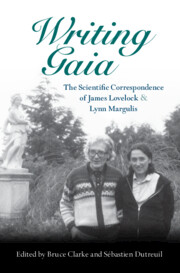Book contents
- Writing Gaia: The Scientific Correspondence of James Lovelock and Lynn Margulis
- Reviews
- Writing Gaia: The Scientific Correspondence of James Lovelock and Lynn Margulis
- Copyright page
- Epigraph
- Table of Contents
- Figures
- Contributors
- Foreword by James Lovelock
- Preface
- Acknowledgements
- Introduction
- Part I 1970–1972
- Part II 1973–1979
- Part III 1980–1991
- Part IV 1992–2007
- Part V Commentaries on Lovelock and Margulis
- Glossary of Names
- Glossary of Terms
- Bibliography
- Index
Part IV - 1992–2007
Published online by Cambridge University Press: 28 July 2022
- Writing Gaia: The Scientific Correspondence of James Lovelock and Lynn Margulis
- Reviews
- Writing Gaia: The Scientific Correspondence of James Lovelock and Lynn Margulis
- Copyright page
- Epigraph
- Table of Contents
- Figures
- Contributors
- Foreword by James Lovelock
- Preface
- Acknowledgements
- Introduction
- Part I 1970–1972
- Part II 1973–1979
- Part III 1980–1991
- Part IV 1992–2007
- Part V Commentaries on Lovelock and Margulis
- Glossary of Names
- Glossary of Terms
- Bibliography
- Index
Summary
During the 1980s, Gaia was perhaps the hottest topic in the Earth sciences. Lovelock and his colleagues published ground-breaking scientific papers. A 1985 TV documentary was dedicated to the story of Gaia, including interviews with Margulis, Lovelock, Richard Dawkins, and others. In March 1988, the American Geophysical Union sponsored a Chapman conference on the Gaia hypothesis. This major scientific decade for Gaia also saw the start of a wide-ranging reconfiguration of the Earth sciences, leading in coming decades to the constitution of the IGBP and NASA’s promotion of Earth system science. However, the correspondence for this decade records the first appreciable rifts in their working relationship. Lovelock’s Daisyworld project for a computer model of Gaian self-regulation, intensively developed in collaboration with Andrew Watson, marked the first significant divergence in effort between Gaia’s primary collaborators. Lovelock and Margulis effectively repaired their collaboration not with a renewed research effort but rather with a new book project developing Lovelock’s second book, The Ages of Gaia.
Keywords
- Type
- Chapter
- Information
- Publisher: Cambridge University PressPrint publication year: 2022



